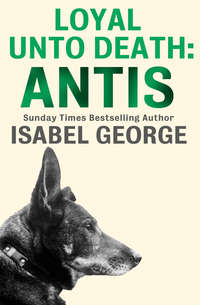
Полная версия
Prisoner of War: Judy

Prisoner of War
Judy
A Short Tale from The Dog that Saved My Life:
Sacrifice. Loyalty. Love beyond all bounds
by Isabel George

Dedication
To my children Luke, Lydia and Jamie…for their
encouragement and for never tiring of these
wonderful stories.
Epigraph
‘She was in her short lifetime an inspiration of courage, hope and a will to live, to many who would have given up in their time of trial…
(Frank Williams, Leading Aircraftsman, RAF)
Contents
Cover
Title Page
Dedication
Epigraph
Chapter 1
Chapter 2: Judy – Prisoner of War 81A Gloergoer, Medan
Afterword
About the Author
Copyright
About the Publisher
Chapter 1
It’s one of life’s little secrets, the bravery of animals in conflict.
Animals have accompanied man into battle since war was first waged. Over two thousand years ago Hannibal took war elephants, soldiers and supplies over the Alps. The giant animals negotiated narrow snow-covered mountain passes, risking life and limb to face the mighty Roman army. Centuries before that, the Ancient Egyptians recorded in their intricate paintings how they proceeded into battle with hundreds of horses pulling chariots, men holding hungry lions straining at the leash and falconers with trained hawks poised to do harm. The animals were there to play their part in the many military confrontations fought to secure supremacy.
Since those times, many stories have been told of the bears, camels, cats, dolphins, monkeys, mules, pigeons, rats and other creatures that have served with the Armed Forces during both world wars and beyond. Some were trained to perform specific tasks, like the dolphins deployed to detect underwater explosives, the pigeons released to deliver vital messages, mules laden with valuable supplies and rats sent running in tunnels to lay communication cables on the front line. Many others were present as mascots; the bears, cats and canaries were not trained to perform any role in particular but provided heartfelt companionship, warmth and humour, and helped create an incredible morale. Many animals have fulfilled this role, but perhaps none more universally and consistently than the dog.
The five stories featured in this book represent the devotion and unquestioning loyalty of the canine companion in the darkest days of war. From the life-saving actions of a Second World War Army mascot under fire to the undoubted trust shared between the Tracker dog and his handler during the war in Vietnam. Man’s best friend is a constant in an uncertain environment and a welcome friend. They are a testament to companionship and to partnership when lives depend on them.
Dogs continue to prove themselves to be fearlessly loyal in all theatres of war, from the hidden depths of jungle warfare in Vietnam and Malaya to the guard and patrol duties of a desert dog in Iraq or Afghanistan. Unlike the horses of the First World War dragged down in the mud of Flanders’ fields, the dog’s speed and agility has always made him an asset on any battlefield. Intelligent and obedient, the dog could be the perfect messenger, able to skip over the trenches or through a minefield faster than any man. Not only are they more successful at such tasks than a human but they, although it hurts to say it, are also far more dispensable. That has always been and will continue to be a fact of wartime life. If a dog detects a landmine he is unlikely to be harmed and his actions will protect all around him. A man is unlikely to be so lucky.
Whether dropped by parachute into enemy country, helicoptered in and out of war zones, or transported in armoured vehicles, dogs have shown their versatility in war. Dogs do what’s required of them and their keen sense of loyalty keeps them faithful to their duties and their military masters. Considering that the majority of the dogs recruited for service in both world wars were pet dogs donated for war service, their sacrifice was immeasurable. They were loaned to the War Office, trained for duty and distributed to the Armed Forces after 12 weeks’ training. The dogs then served their country, and if they survived they were returned to their owner. These dogs took this all in their stride and the lucky ones returned to life as a fireside pet in peacetime. But for every treasured family pet to be returned home safely, there were countless others who died alongside their comrades. And for all these canine heroes, there were young soldiers, sailors and airmen who had faced horror and death and who had seen those around them lost forever, who had taken immense comfort and support from these brave, devoted companions.
The war dog is not just a feature of conflicts past. Dogs are still used in contemporary warfare and have seen service in Bosnia, Kosovo, Iraq and Afghanistan. Guard and patrol dogs remain an essential element of life on any military base at home and overseas but the role of the Arms and Explosives Search dog is one that has recently come to the fore. Trained to detect and locate weapons, explosives and bomb-making equipment, these dogs are life-savers on a daily basis. They protect the life of their handler and save the lives of military and civilian personnel with each successful ‘find’. Dogs may still be listed as ‘equipment’ but no machine and no man can match the skill of a trained search dog. Wartime strategies and hardware may come and go but the skill of a war dog remains constant and irreplaceable.
Within the ranks, the war dog is regarded as nothing less than a fellow ‘soldier’, a colleague and a companion. Over the years Service dogs and mascot dogs have been decorated for their life-saving bravery in conflict. Many have lost their lives in saving others and their fellow soldiers have deemed it vital to recognize their incredible service and sacrifice to mankind.
For these animals to give so much when they are innocent in the ways of the world and war deserves recognition. These are just five stories of many, and all are awe inspiring and heart warming in equal measure. Maybe even the dogs would ask for them to be told, and they deserve to be remembered – for all time.
Chapter 2 Judy – Prisoner of War 81A Gloergoer, Medan
‘Where’s Judy? Has anyone seen her?’
British warship HMS Grasshopper had been torpedoed. Out of the dark, cold and oily water a sailor shouted to his shipmates in the hope that someone had seen Judy, the ship’s mascot. Just moments before the ship was hit, Judy was in her usual place enjoying extra rations in the ship’s galley. She belonged to the entire crew and they all looked after her. She was a lucky mascot who, on her previous ship, HMS Gnat, had been shelled and almost drowned in the Yangtze River. It seemed Judy was in the wrong place at the wrong time once again.
When Singapore fell to the Japanese in February 1942, Grasshopper, a 585-ton river gunboat, left Keppel Harbour in Singapore, bound for Java, her sister ship HMS Dragonfly alongside her. Spotted by a Japanese seaplane both ships were dive bombed. Grasshopper, already battle-scarred from the Malaya-Singapore campaign, took a hit under her bow. Commander Hoffman decided to lay-up his ship in a group of islands to the north of Sinkep, but two miles short of safety the ships came under fire again. Two formations of 81 Japanese bombers passed overhead. Nine of the planes at five-minute intervals dropped their bombs and a mile from land the Grasshopper was hit astern and set on fire. Many of the 75 crew and 50 passengers (Japanese POWs, Royal Marines, Army officers and civilians) jumped overboard and swam for their lives as the commander beached his ship, which took two more hits before it had to be abandoned.
The survivors, marooned on one of the tiny uninhabited islands in the region, gradually gathered together on the sand. They were in desperate straits. There was very little food to salvage from what was left of the Grasshopper and there was no fresh water. Judy had suddenly appeared in the group, much to the relief of the remaining crew. They had lost sight of her in the mayhem of the bombing and assumed she had run for cover in the depths of the ship. Wherever she had been hiding she had, at some stage, made the wise move to head for the water. Weary and covered in oil, the bedraggled dog wandered between the few survivors. The Grasshopper and Dragonfly had suffered heavy loss of life and those who survived were, like Judy, hungry and thirsty.
The group’s priority had been to locate fresh water but for some reason they had not thought to include Judy in their search. After two days, given the poor condition of some of the wounded and the intense heat, the men knew they were on borrowed time and the search for water became desperate. It was one of the ship’s crew who noticed Judy sniffing and digging near the shore line. The man drew the others’ attention to what Judy was doing and a few of them decided to shadow her. Moving up and down the beach, her nose so close to the sand it was touching her nostrils, Judy detected something. No one was quite sure if she had found something to eat, or uncovered a sea creature, or was just doing what dogs do but they kept an eye on her. Enough of the survivors knew to trust a dog’s nose, which was so much more sensitive than any human’s. They were right to trust Judy’s canine instincts. Two hours later when the tide was out, Judy returned to the chosen spot and started drinking from a spring bubbling up from the sand. Still not sure what the dog was doing, the crew took a closer look. Judy had led the men to a fresh-water spring under the sand. At first no one could believe that the dog had discovered the water, and some were a little unsure if it really was fresh water, but they knew that if they didn’t try it they would be dead anyway. Judy was drinking from it and she was fine. Within minutes everyone was crowding around her, scooping up handfuls of the spring water and giving Judy lots of praise. She had saved their lives. And they knew it.
Judy, a pure-bred liver-and-white English pointer, born in Shanghai in 1937 and promptly presented to the Royal Navy as a mascot, had now proven herself to be more than a pet. She was now regarded as a valuable member of the team and was about to start the greatest adventure of her life. Up to this point she had served loyally as a mascot in several ships. She was a survivor and inspired others to aim for the same. Her expertise at finding water had been a godsend. It was several days before the men were presented with the opportunity to commandeer a passing Chinese junk to take them off the island and once again Judy was a ship’s mascot, a member of a crew. Respected by all around her, Judy was watched over by the small band of survivors, who regarded her as their guardian angel. Only imagining what lay ahead of them, they knew they just might need that angel again. Filling every container that had washed ashore from the galley with spring water, the men gathered up their mascot dog and boarded the junk.
They set sail for the north-east coast of Sumatra, where they then began a 200-mile trek cross-country to Padang on the west coast of the island, hoping to be able to pick up another boat sailing to India or Ceylon (Sri Lanka) and make their way back to England from there. Walking, hitch-hiking, taking lifts on lorries and river craft, the men made their way. They would only use transport that could take Judy, as there was no way they were going to leave her behind. It was never going to be an easy journey, but having lost every contact possible with the outside world, the Grasshopper’s survivors had no idea what was happening around them and, more critically, had no idea of the extent or the position of the Japanese advance. The heat was oppressive and with the water already severely rationed each of the forty or so people walking were on the brink of collapse. No one could gauge how long the water would last out and how far they would have to walk to get to safety. All Commander Hoffman knew was that he had to lead these people to a place of security. They walked with blisters on their feet that they had strapped with strips of their own clothing. They had very little food other than the fruit they knew to be safe off the trees and the generous donations from villages they came across as they trekked on and on through the dense jungle. Each clearing they came to gave rise to very mixed feelings -dread that they were entering enemy territory, or hope that they were safe at last. Village after village emerged out of the undergrowth. It took Commander Hoffman an arduous nine days to get his party within a few miles of Padang. Then, unsuspectingly, their journey almost done, the men stumbled into a Japanese-held village and were immediately taken prisoner. It all happened so quickly. The enemy had probably been watching the group of stragglers for some time before waiting to ambush them as came into the village clearing. With bayonets pointing at their chests and with the sound of Japanese soldiers shrieking orders the survivors of the Grasshopper were marshalled into line. It was the beginning of three years of captivity as Japanese prisoners of war in Sumatra – and for Judy too.
Desperate to stay close to the rest of the crew, Judy managed to board the truck bound for the POW camp without being seen. Petty Officer Puncheon grabbed several rice sacks and placed them on top of her, giving her a whispered order to ‘stay…still’. The men slipped her water and a little food when they could over the five days it took for them to reach the camp at Rengat. It was here that Leading Aircraftsman Frank Williams set eyes on Judy for the first time. ‘I didn’t know who she was,’ recalled Frank many years later, ‘but I remember thinking what on earth is a beautiful English pointer like that doing over here and with no one to care for her. I later learnt that she was a mascot of HMS Grasshopper and I realized that even though she looked thin and frail she was a true survivor.’
Frank recognized the same qualities in Judy that he must have recognized in himself, but was far too modest to ever admit. A tall, handsome man with dark wavy hair, a kind face and gentle eyes, at that time untouched by the ravages of years in a prison camp, Frank arrived at Rengat on 13 February 1942 but his journey began weeks before when he was attached to a radar unit operating from a secret location in a rubber plantation in Singapore. The unit received an order to board the SS Tien Kwong, a small Royal Navy-operated vessel with small-scale armaments that was tasked with evacuating Service personnel to fight in Java in the event of Singapore falling to the Japanese; and so Frank gathered the valuable radar equipment, destroyed everything else and boarded the boat. The Tien Kwong wound its way through the minefields at the entrance to Singapore and into open water. But it didn’t take long for Japanese reconnaissance aircraft to pick her up, report her position to the Japanese Air Force and for them to release a squadron of bombers to blow her out of the water.
When the order was given to abandon ship, Frank hoped the bombing had scared the sharks well away as he realized he had a 300-yard swim to shore ahead of him. But the sharks weren’t the only danger in these waters. Two other ships, HMS Kungwo and HMS Kuala, came under Japanese fire. Suddenly the water between ship and shore was alight with burning oil and littered with debris and bodies and people swimming for their lives, as the Japanese planes circled the area releasing their bombs. Many of the passengers on the Kungwo were women and children being evacuated from Singapore. Their burnt bodies mingled with those of the military personnel from the other ships.
Frank and his friends tried to get as far away as possible by capturing a local boat and heading for Padang. Picking up supplies of water and coconuts they headed off in their junk. Like the crew of the Grasshopper, they hoped to board a ship to India from there. Unfortunately, their craft did not last the distance down the Indragiri River and had to be abandoned for a truck. By the time they reached Padang, Frank and his friends could go no further. The boat had left for Ceylon and the smaller civilian boats they took from Padang harbour were intercepted by the Japanese. Some did make it to Ceylon but Frank was finally cornered with others planning to escape the grasp of the Japanese. Finally they were rounded up, detained for three months in barracks in Rengat and then transferred north to the POW camp in Medan, where Judy had arrived just days before.
Unsure if anyone had taken the dog under their wing, Frank observed Judy for a while. He saw her wandering and scrounging for food, seemingly half-forgotten and never attached to anyone in particular. Frank remembered first setting eyes on Judy in March 1942 in Rengat; it was now August and he decided he had watched enough of this mournful dog’s suffering, and so decided to adopt her. The next afternoon, while the prisoners lined up for their daily ration of rice to be slopped out, Frank decided he would share his with Judy. He took his turn in the queue and headed for his usual place to sit and eat. Judy was around, always, sniffing the ground as she weaved in and out of the crouched figures, heads down and hands in their palm-size bowl, scooping up the grey slop that masqueraded as food. Each person took their ration and, before taking a spoonful, searched through it for signs of life, mainly wriggling maggots. Judy would often move in for the kill when a maggot was flicked to the floor. Making her usual rounds she made her way to Frank’s side. Since he arrived, Frank had always been one to save her the odd crumb, so she was used to getting a morsel of food and lots of attention from this fellow prisoner. She eagerly wagged her tail as she swaggered towards him and then did her usual ‘sit and stay’ pose, which would usually get her a treat. But instead of offering her a grain or two to lick from his fingers, Frank held out the rice bowl. ‘Come on Judy…this is yours,’ he said. And without hesitation, Judy buried her muzzle into the bowl and lapped up the contents in seconds. Frank held tight to the bowl as Judy licked it cleaner than clean. She nuzzled Frank’s arm as if to say, ‘Thank you’, then lay at his feet and stayed there all day.
Конец ознакомительного фрагмента.
Текст предоставлен ООО «ЛитРес».
Прочитайте эту книгу целиком, купив полную легальную версию на ЛитРес.
Безопасно оплатить книгу можно банковской картой Visa, MasterCard, Maestro, со счета мобильного телефона, с платежного терминала, в салоне МТС или Связной, через PayPal, WebMoney, Яндекс.Деньги, QIWI Кошелек, бонусными картами или другим удобным Вам способом.







